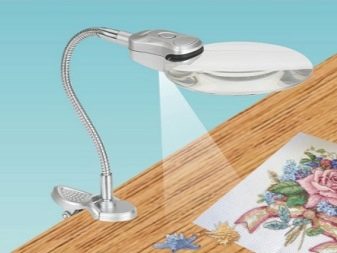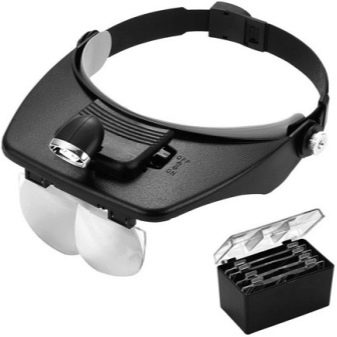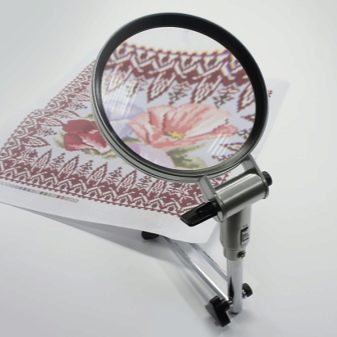Many craftswomen in the process of embroidery, sewing or knitting use a magnifying glass for needlework, which is a special magnifier. Similarly, you can consider the smallest details. Using a magnifier allows you to protect your eyes from excessive overvoltage and creates the conditions for a quiet creative process without negative consequences for the organs of vision.
By the way, such a tool is used not only by needlewomen, it is in demand among numismatists, philatelists and other collectors.


Features
A magnifier is a device that allows you to view the smallest objects, repeatedly increasing them. The device was invented by Anthony Van Levenguk, it was he who first polished the mirror to present this miracle invention to the world. Nowadays, in any stationery or needlework store you can buy magnifiers of various types. Their design is extremely simple: on the one hand, the glass has a slightly convex shape, and on the other, it is flat. For creativity, mainly using magnifiers with highlighting.
It is important that they exactly meet a number of important criteria.
- The design must provide for mandatory protection against chips and scratches.
- Such magnifiers should be comfortable in the palm of your hand or firmly placed on a horizontal surface, so that your hands will be free, this allows you to do creative work without interruption.
- Optimally, if the backlight will have its own independent power source.


Why is it needed?
The main advantage of the magnifier for needlework is its exceptional simplicity.The product has a convenient clothespin, thanks to which it can be fixed on any horizontal and vertical surfaces. A slightly more complex device is a desktop magnifier for creativity, but it is it that allows you to provide a detailed examination of even the smallest elements.
Among the other advantages of such equipment can be noted:
- release of both hands for effective work;
- the possibility of use at any time of the day, including evening and night, so as not to interfere with the rest of the household;
- a significant reduction in the load on the organs of vision.


Varieties
Magnifying glass for craftswomen is usually classified immediately for several reasons. The most common criteria are their operational features. Magnifying glasses for creative work are presented in several formats:
- tabletop;
- forehead;
- on a small tripod;
- portable.


Depending on the type of magnifying system, such options are distinguished.
- Simple lenses. This is the most primitive and common option, which involves the use of a single positive lens. A similar model can be used in cases where a rare small increase is required.
- Double lens. In this case, the design is based on the use of two simple, not fixed to each other lenses. This model provides maximum hue adjustment and allows you to consider the smallest elements.
- Doublet achromat. A full-fledged optical installation that works on the principle of large multiplicities. The design includes collecting as well as scattering lenses.
- Triplet. In this case, three types of magnifying glasses are used at once, which prevents the possibility of image distortion. Such a device is relevant when working with a high degree of accuracy.


Backlit models, in turn, fall into two main categories: they can have LED or luminescent design. The first type has low power consumption and a rather impressive operating mode, which involves operation for 50 thousand hours. The advantage of such equipment is non-blinking type of glow.
Luminescent backlighting is characterized by an increased degree of maintainability and a relatively good working resource - up to 20 thousand hours.
Such models win at their price, they are cheaper and more affordable than systems with LED-backlight.


Popular models
- Comparators - such a magnifier is additionally equipped with metallized sighting threads, which allow you to measure the exact parameters of the holes, thread pitch and other characteristics of small elements.
- Loupes - The magnifier is usually mounted on the frame of the glasses or on the head. Due to this design, the master can free his hands in order to perform any operations. Such magnifying lamps were widely used among jewelers, watchmakers and toolmakers.
- Linen testers - such a magnifier has a folding stand, as well as an impressive grid near the base. It also contributes to maximum hands release. Such equipment is indispensable for checking threads in textiles.
- Hastings triplets - The magnifier has a fairly compact size and a flat field. Corrects color reproduction, so it is popular not only among needlewomen, but also among engravers and retouchers.
- Direct measuring microscopes - in a sense, a mini microscope. It is indispensable if the work requires a 20-fold increase. Using this device allows you to detect the smallest scratches, chips, cracks and other surface defects.


Selection tips
When choosing the best option for magnifying glasses for embroidery and other types of needlework, the emphasis should be on several basic points. The distance from the lens to the object under study should be clarified.For example, when embroidering, it is best to take a magnifier of high magnification, but at the same time with a minimum working distance. Particular attention should be paid to the field of view, the depth of field is considered a fundamental factor.
Additionally, attention should be paid to such points:
- focal length;
- type of lens coating;
- the ratio of the maximum size of the focal length to the length of the diagonal image.


For the maximum comfort of the work of masters, many loops have additional accessoriesin particular, using rotary tripods, all kinds of mounts, as well as clothespins. Thanks to them, you can give the magnifier a position for the most comfortable work. Many models have small stands that ensure the accuracy of the fixation of the device and the stability of its mechanism when working at the table. The presence of clothespins greatly facilitates the inspection of small parts.
In general, all these additional devices are largely contribute to increased productivity and speed of the creative process, but also ensure the safety of the entire workflow.
Most models have a metallized mesh, it is necessary to measure the diameters and dimensions of the smallest elements.
In the next video, you will find an overview of a magnifying glass for needlework with backlight.

